engine Citroen C4 AIRCROSS RHD 2014.5 1.G Service Manual
[x] Cancel search | Manufacturer: CITROEN, Model Year: 2014.5, Model line: C4 AIRCROSS RHD, Model: Citroen C4 AIRCROSS RHD 2014.5 1.GPages: 389, PDF Size: 15.51 MB
Page 113 of 389
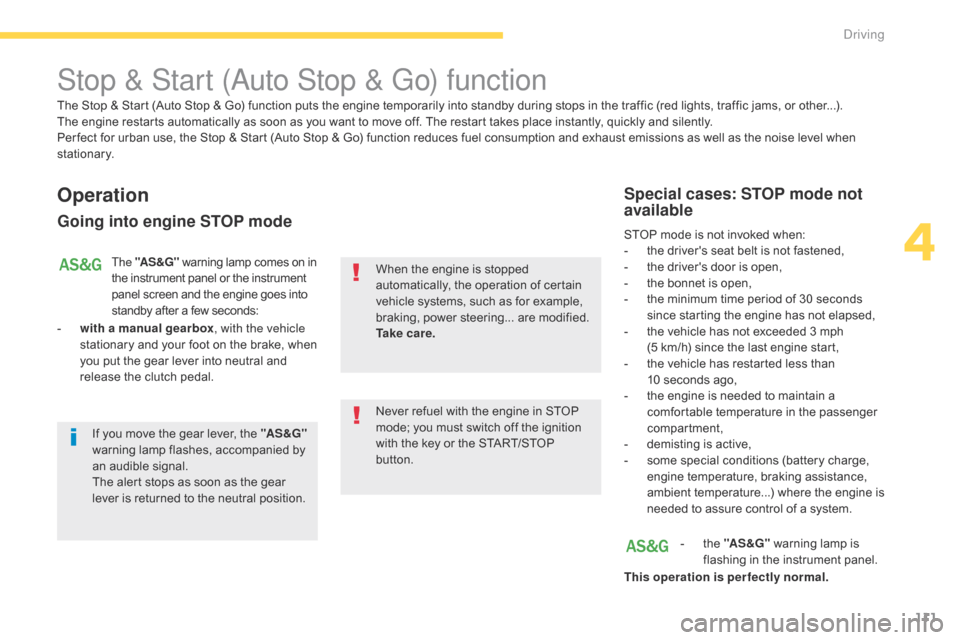
111
Stop & Start (auto Stop & Go) function
Operation
Going into engine STOP mode
The "AS &G" warning lamp comes on in
the instrument panel or the instrument
panel screen and the engine goes into
standby after a few seconds:
-
w
ith a manual gearbox , with the vehicle
stationary and your foot on the brake, when
you put the gear lever into neutral and
release the clutch pedal.
Never refuel with the engine in STOP
mode; you must switch off the ignition
with the key or the START/STOP
button. When the engine is stopped
automatically, the operation of certain
vehicle systems, such as for example,
braking, power steering... are modified.
Ta k e c a r e.
Special cases: STOP mode not
available
STOP mode is not invoked when:
-
t he driver's seat belt is not fastened,
-
t
he driver's door is open,
-
t
he bonnet is open,
-
t
he minimum time period of 30 seconds
since starting the engine has not elapsed,
-
t
he vehicle has not exceeded 3 mph
(5
km/h) since the last engine start,
-
t
he vehicle has restarted less than
10
seconds ago,
-
t
he engine is needed to maintain a
comfortable temperature in the passenger
compartment,
-
d
emisting is active,
-
s
ome special conditions (battery charge,
engine temperature, braking assistance,
ambient temperature...) where the engine is
needed to assure control of a system.
-
t
he "AS &G" warning lamp is
flashing in the instrument panel.
This operation is perfectly normal.
The Stop & Start (Auto Stop & Go) function puts the engine temporarily into standby during stops in the traffic (red lights, traffic jams, or other...).
The
engine restarts automatically as soon as you want to move off. The restart takes place instantly, quickly and silently.
Per fect for urban use, the Stop & Start (Auto Stop & Go) function reduces fuel consumption and exhaust emissions as well as the noise level when
stationary.
If you move the gear lever, the "AS &G"
warning lamp flashes, accompanied by
an audible signal.
The alert stops as soon as the gear
lever is returned to the neutral position.
4
driving
Page 114 of 389
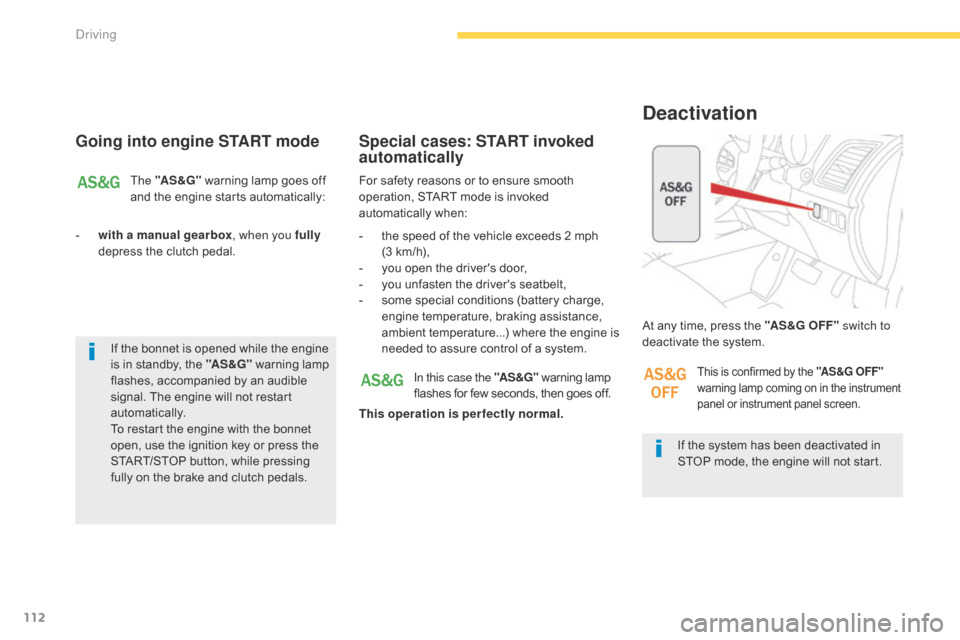
112
Going into engine START mode
The "AS &G" warning lamp goes off
and the engine starts automatically:
-
w
ith a manual gearbox , when you fully
depress the clutch pedal. For safety reasons or to ensure smooth
operation, START mode is invoked
automatically when:
Special cases: START invoked
automatically
- the speed of the vehicle exceeds 2 mph
(3 km/h),
-
y
ou open the driver's door,
-
y
ou unfasten the driver's seatbelt,
-
s
ome special conditions (battery charge,
engine temperature, braking assistance,
ambient temperature...) where the engine is
needed to assure control of a system.
If the system has been deactivated in
STOP mode, the engine will not start.
At any time, press the "AS &G O FF "
switch to
deactivate the system.
Deactivation
In this case the "AS &G" warning lamp
flashes for few seconds, then goes off.
This operation is perfectly normal.This is confirmed by the "AS &G O FF "
warning lamp coming on in the instrument
panel or instrument panel screen.
If the bonnet is opened while the engine
is in standby, the "AS &G" warning lamp
flashes, accompanied by an audible
signal. The engine will not restart
automatically.
To restart the engine with the bonnet
open, use the ignition key or press the
START/STOP button, while pressing
fully on the brake and clutch pedals.
Driving
Page 115 of 389
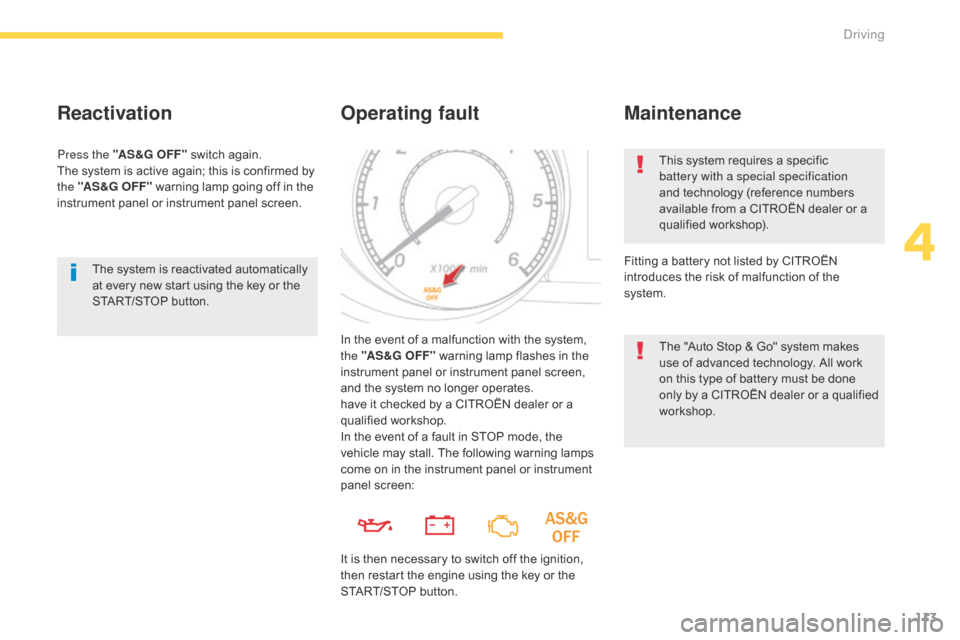
113
The system is reactivated automatically
at every new start using the key or the
START/STOP button.
Reactivation
Press the "AS &G O FF " switch again.
The system is active again; this is confirmed by
the "AS &G O FF " warning lamp going off in the
instrument panel or instrument panel screen.
Operating fault
In the event of a malfunction with the system,
the "AS &G O FF " warning lamp flashes in the
instrument panel or instrument panel screen,
and the system no longer operates.
have it checked by a CITROËN dealer or a
qualified workshop. This system requires a specific
battery with a special specification
and technology (reference numbers
available from a CITROËN dealer or a
qualified workshop).
Fitting a battery not listed by CITROËN
introduces the risk of malfunction of the
system.
Maintenance
The "Auto Stop & Go" system makes
use of advanced technology. All work
on this type of battery must be done
only by a CITROËN dealer or a qualified
workshop.
In the event of a fault in STOP mode, the
vehicle may stall. The following warning lamps
come on in the instrument panel or instrument
panel screen:
It is then necessary to switch off the ignition,
then restart the engine using the key or the
START/STOP button.
4
Driving
Page 121 of 389
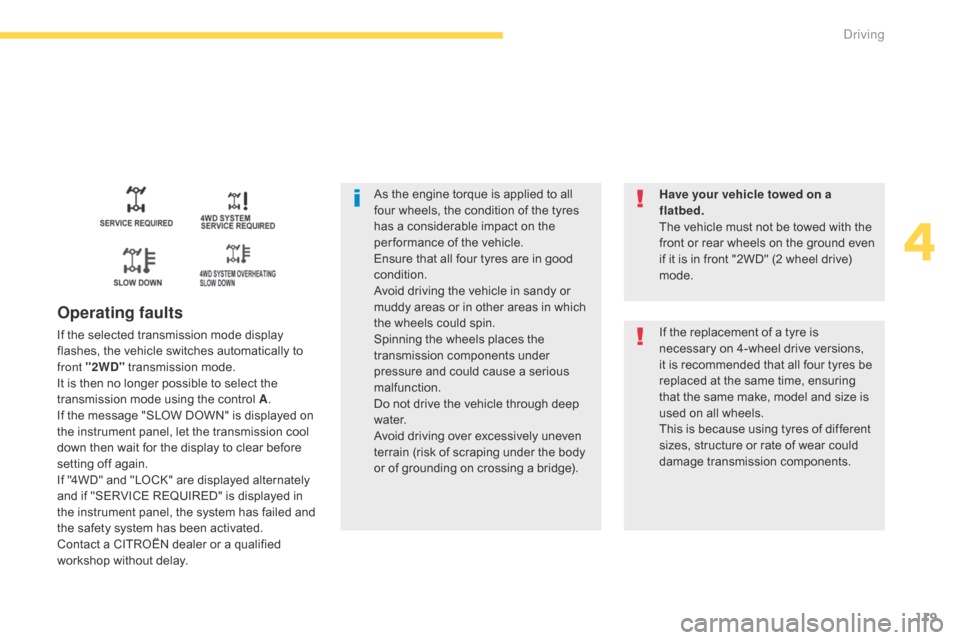
119
As the engine torque is applied to all
four wheels, the condition of the tyres
has a considerable impact on the
per formance of the vehicle.
Ensure that all four tyres are in good
condition.
Avoid driving the vehicle in sandy or
muddy areas or in other areas in which
the wheels could spin.
Spinning the wheels places the
transmission components under
pressure and could cause a serious
malfunction.
Do not drive the vehicle through deep
water.
Avoid driving over excessively uneven
terrain (risk of scraping under the body
or of grounding on crossing a bridge).
Operating faults
If the selected transmission mode display
flashes, the vehicle switches automatically to
front "2WD" transmission mode.
It is then no longer possible to select the
transmission mode using the control A .
If the message "SLOW DOWN" is displayed on
the instrument panel, let the transmission cool
down then wait for the display to clear before
setting off again.
If "4WD" and "LOCK" are displayed alternately
and if "SERVICE REQUIRED" is displayed in
the instrument panel, the system has failed and
the safety system has been activated.
Contact a CITROËN dealer or a qualified
workshop without delay. Have your vehicle towed on a
flatbed.
The vehicle must not be towed with the
front or rear wheels on the ground even
if it is in front "2WD" (2 wheel drive)
mode.If the replacement of a tyre is
necessary on 4-wheel drive versions,
it is recommended that all four tyres be
replaced at the same time, ensuring
that the same make, model and size is
used on all wheels.
This is because using tyres of different
sizes, structure or rate of wear could
damage transmission components.
4
Driving
Page 132 of 389
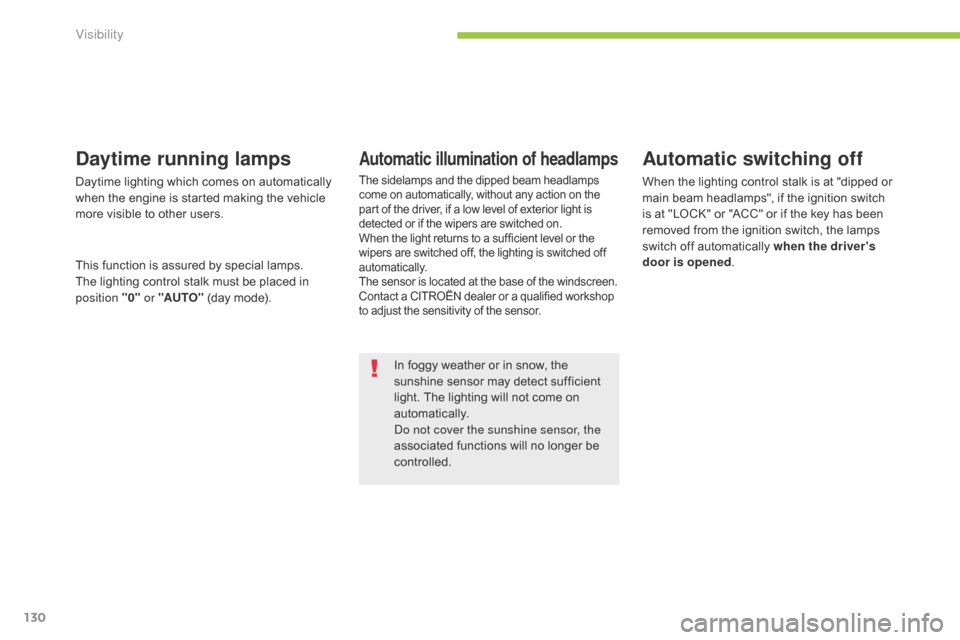
130
In foggy weather or in snow, the
sunshine sensor may detect sufficient
light. The lighting will not come on
automatically.
do n
ot cover the sunshine sensor, the
associated functions will no longer be
controlled.
Automatic switching off
When the lighting control stalk is at "dipped or
main beam headlamps", if the ignition switch
is at "LOCK" or "ACC" or if the key has been
removed from the ignition switch, the lamps
switch off automatically when the driver's
door is opened .
Daytime running lamps
Daytime lighting which comes on automatically
when the engine is started making the vehicle
more visible to other users.
This function is assured by special lamps.
The lighting control stalk must be placed in
position "0" or "AUTO" (day mode).
Automatic illumination of headlamps
The sidelamps and the dipped beam headlamps
come on automatically, without any action on the
part of the driver, if a low level of exterior light is
detected or if the wipers are switched on.
When the light returns to a sufficient level or the
wipers are switched off, the lighting is switched off
automatically.
The sensor is located at the base of the windscreen.
Contact a CITROËN dealer or a qualified workshop
to adjust the sensitivity of the sensor.
Visibility
Page 141 of 389
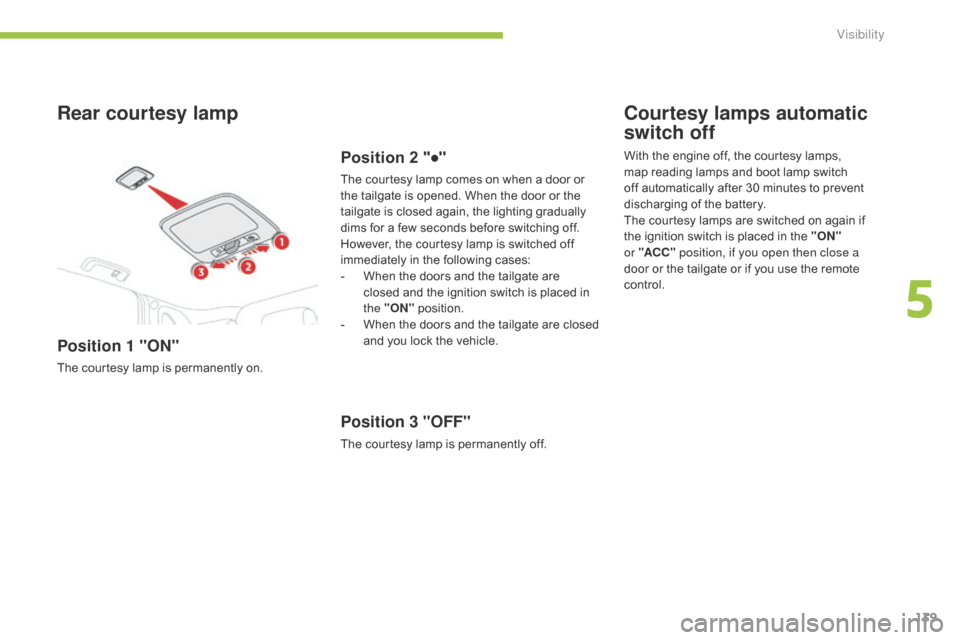
139
Rear courtesy lamp
Position 1 "ON"
The courtesy lamp is permanently on.
Position 2 "●"
The courtesy lamp comes on when a door or
the tailgate is opened. When the door or the
tailgate is closed again, the lighting gradually
dims for a few seconds before switching off.
However, the courtesy lamp is switched off
immediately in the following cases:
-
W
hen the doors and the tailgate are
closed and the ignition switch is placed in
the
"ON" position.
-
W
hen the doors and the tailgate are closed
and you lock the vehicle.
Position 3 "OFF"
The courtesy lamp is permanently off.
Courtesy lamps automatic
switch off
With the engine off, the courtesy lamps,
map reading lamps and boot lamp switch
off automatically after 30 minutes to prevent
discharging of the battery.
The courtesy lamps are switched on again if
the ignition switch is placed in the "ON"
or "ACC " position, if you open then close a
door or the tailgate or if you use the remote
control.
5
Visibility
Page 146 of 389
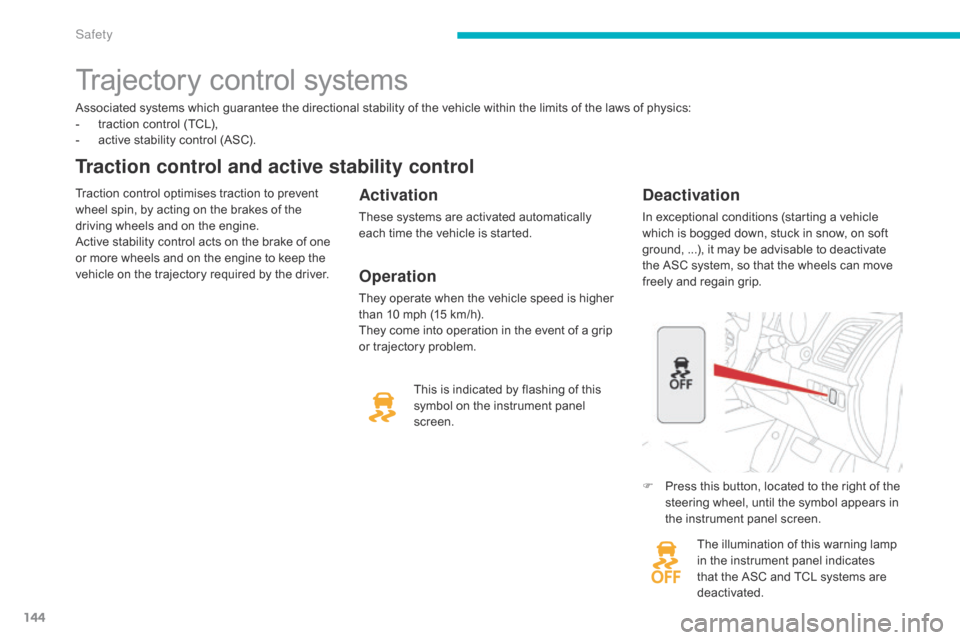
144
Associated systems which guarantee the directional stability of the vehicle within the limits of the laws of physics:
- t raction control (TCL),
-
a
ctive stability control (ASC).
Traction control and active stability control
Traction control optimises traction to prevent
wheel spin, by acting on the brakes of the
driving wheels and on the engine.
Active stability control acts on the brake of one
or more wheels and on the engine to keep the
vehicle on the trajectory required by the driver.Activation
These systems are activated automatically
each time the vehicle is started.
The illumination of this warning lamp
in the instrument panel indicates
that the ASC and TCL systems are
deactivated.
Deactivation
In exceptional conditions (starting a vehicle
which is bogged down, stuck in snow, on soft
ground, ...), it may be advisable to deactivate
the ASC system, so that the wheels can move
freely and regain grip.
This is indicated by flashing of this
symbol on the instrument panel
screen.
Trajectory control systems
F Press this button, located to the right of the steering wheel, until the symbol appears in
the instrument panel screen.
Operation
They operate when the vehicle speed is higher
than 10 mph (15 km/h).
They come into operation in the event of a grip
or trajectory problem.
Safety
Page 190 of 389
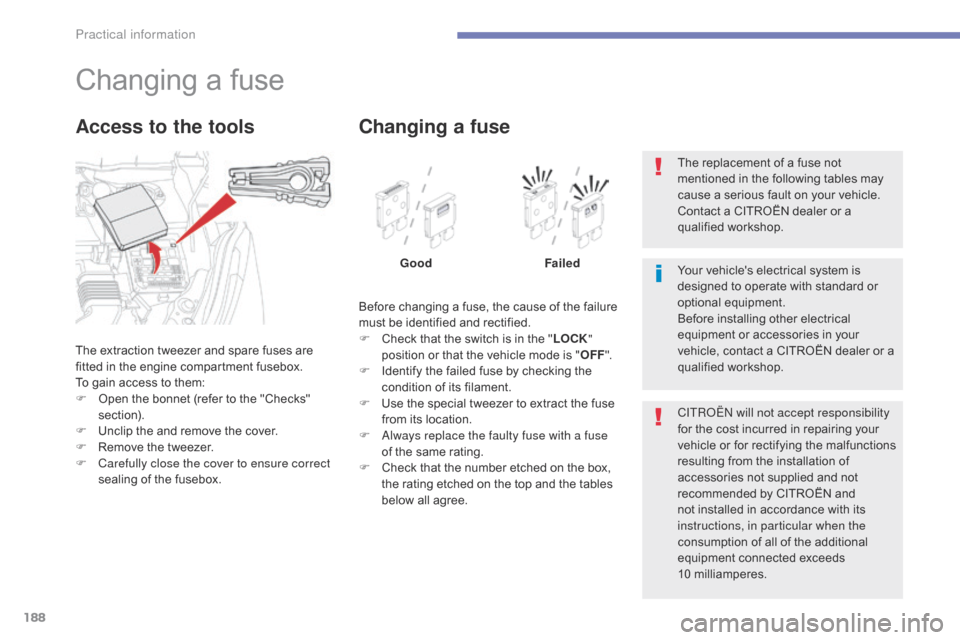
188
Changing a fuse
The extraction tweezer and spare fuses are
fitted in the engine compartment fusebox.
To gain access to them:
F
O
pen the bonnet (refer to the "Checks"
section).
F
U
nclip the and remove the cover.
F
R
emove the tweezer.
F
C
arefully close the cover to ensure correct
sealing of the fusebox.
Access to the tools
Before changing a fuse, the cause of the failure
must be identified and rectified.
F
C
heck that the switch is in the " LOCK"
position or that the vehicle mode is " OFF".
F
I
dentify the failed fuse by checking the
condition of its filament.
F
U
se the special tweezer to extract the fuse
from its location.
F
a
l
ways replace the faulty fuse with a fuse
of the same rating.
F
C
heck that the number etched on the box,
the rating etched on the top and the tables
below all agree.
Changing a fuse
Good Failed
CITR
oËn
will not accept responsibility
for the cost incurred in repairing your
vehicle or for rectifying the malfunctions
resulting from the installation of
accessories not supplied and not
recommended by CITROËN and
not installed in accordance with its
instructions, in particular when the
consumption of all of the additional
equipment connected exceeds
10
mil
liamperes.
Your vehicle's electrical system is
designed to operate with standard or
optional equipment.
Before installing other electrical
equipment or accessories in your
vehicle, contact a CITROËN dealer or a
qualified workshop. The replacement of a fuse not
mentioned in the following tables may
cause a serious fault on your vehicle.
Contact a CITROËN dealer or a
qualified workshop.
Practical information
Page 193 of 389
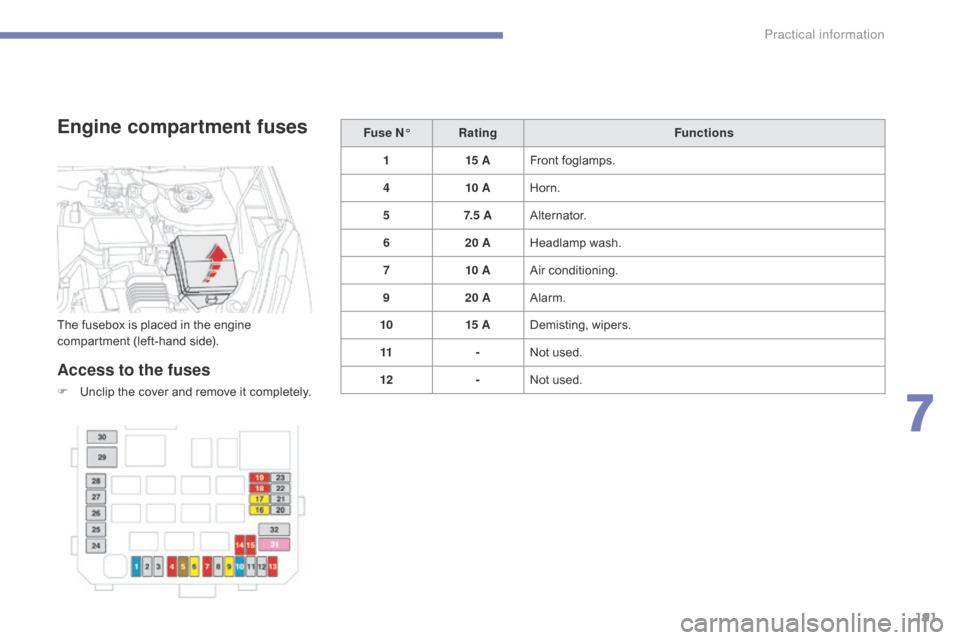
191
Engine compartment fuses
Access to the fuses
F Unclip the cover and remove it completely.Fuse N°
Rating Functions
1 15 AFront foglamps.
4 10 AHorn.
5 7. 5 AAlternator.
6 20 AHeadlamp wash.
7 10 AAir conditioning.
9 20 AAlarm.
10 15 ADemisting, wipers.
11 -Not used.
12 -Not used.
The fusebox is placed in the engine
compartment (left-hand side).
7
Practical information
Page 194 of 389
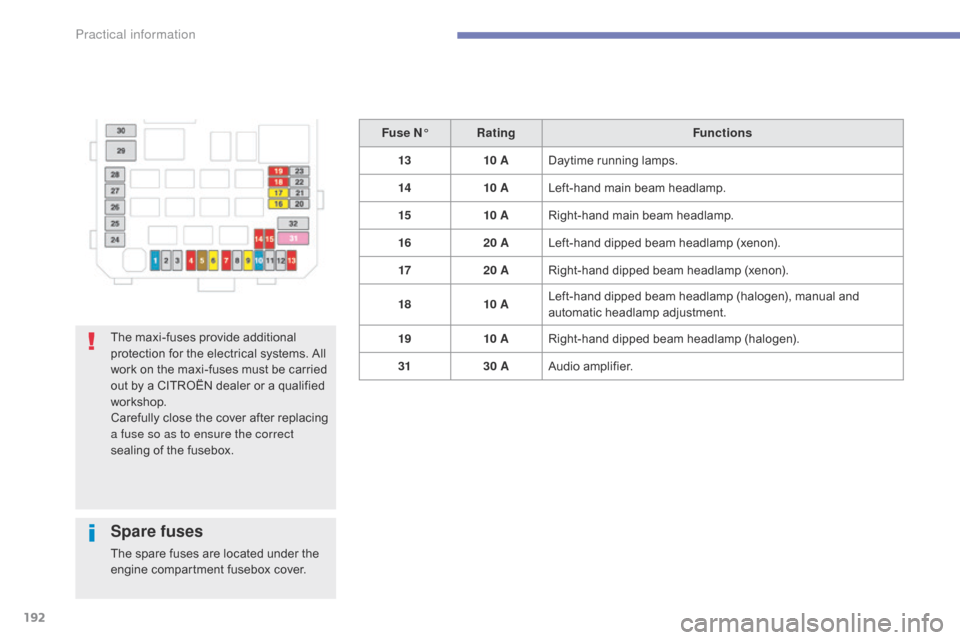
192
Fuse N°Rating Functions
13 10 ADaytime running lamps.
14 10 ALeft-hand main beam headlamp.
15 10 ARight-hand main beam headlamp.
16 20 ALeft-hand dipped beam headlamp (xenon).
17 20 ARight-hand dipped beam headlamp (xenon).
18 10 ALeft-hand dipped beam headlamp (halogen), manual and
automatic headlamp adjustment.
19 10 ARight-hand dipped beam headlamp (halogen).
31 30 AAudio amplifier.
The maxi-fuses provide additional
protection for the electrical systems. All
work on the maxi-fuses must be carried
out by a CITROËN dealer or a qualified
workshop.
Carefully close the cover after replacing
a fuse so as to ensure the correct
sealing of the fusebox.
Spare fuses
The spare fuses are located under the
engine compartment fusebox cover.
Practical information